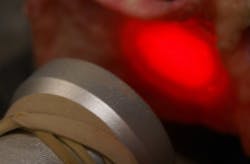Near-IR light penetrates skull to aid traumatic brain injury
Researchers have found a unique method of applying high-powered near-infrared light (NIR) that can penetrate the skin and skull to reach the damaged portions of the brain for individuals suffering from traumatic brain injury (TBI), and effectively accelerate regeneration of the brain cells' functionality with minimal skin irritation.
RELATED ARTICLE: Light therapy restores vision to stroke survivors
Published in the Neuropsychiatric Disease and Treatment, the study "Near-infrared photonic energy penetration: can infrared phototherapy effectively reach the human brain?" was conducted and authored by Theodore Henderson, MD and Larry Morries, DC, co-founders of the Neuro-Laser Foundation (Denver, CO).
The study compared penetration levels of low-power NIR, such as that from light-emitting diodes (LEDs) with high-power NIR on skin, bone, tissue, and brain. The findings include (1) that low-power infrared light in the milliwatt range does not penetrate a full thickness section of human skin (2 mm), nor does it deliver any significant infrared energy to a depth of 3 cm into the brain; (2) high-power infrared light achieved at least 3 cm penetration into the brain—this included wavelengths of 980 and 808 nm with 9-13 W average power; (3) a "pulsed" application of NIR light might be more effective than continuous wave light; (4) no thermal skin irritation occurred, and skin temperature change was negligible; and (5) existing medical assumptions about the penetration of NIR underlying current medical applications are faulty.
"Our data show that LED and low level NIR offer at best transient benefit, and often do not even penetrate through the skin," said Henderson. "Our data shows no significant amount of light gets to the areas needing to be treated."
Previous work by Henderson and others has shown that the most common areas injured in the human brain are the bottom of the frontal lobes and the temporal lobes which can be 3-7 cm from the scalp.
The Center for Disease Control reports more 2.5 million concussion and TBI emergency visits occur annually. According to Henderson, symptoms of persistent TBI can include headaches, speech irregularities, confusion, memory slips, lack of impulse control, sleep disturbance, anxiety, depression, and for some, suicide.
"Other groups and our current work have shown that NIR can improve TBI, but only if it is delivered with sufficient energy to the brain. We must caution consumers against claims of benefit from treatments using NIR at the milliwatt level," said Henderson, who co-founded the Neuro-Laser Foundation to expand NIR treatment offerings and research. "After we identify the damaged location, we can apply our NIR method directly to the area and give new life to previously dormant brain cells. It's a breakthrough, and will provide a much-needed relief for all those struggling for answers to TBI."
SOURCE: Neuro-Laser Foundation via PR Newswire; http://www.prnewswire.com/news-releases/new-study-shows-only-high-powered-near-infrared-light-nir-regenerates-damage-from-traumatic-brain-injury-tbi-300143969.html
About the Author

Gail Overton
Senior Editor (2004-2020)
Gail has more than 30 years of engineering, marketing, product management, and editorial experience in the photonics and optical communications industry. Before joining the staff at Laser Focus World in 2004, she held many product management and product marketing roles in the fiber-optics industry, most notably at Hughes (El Segundo, CA), GTE Labs (Waltham, MA), Corning (Corning, NY), Photon Kinetics (Beaverton, OR), and Newport Corporation (Irvine, CA). During her marketing career, Gail published articles in WDM Solutions and Sensors magazine and traveled internationally to conduct product and sales training. Gail received her BS degree in physics, with an emphasis in optics, from San Diego State University in San Diego, CA in May 1986.
